
The article highlights a lot of jargon-y words that people use, like leverage and disrupt and iteration, more often than they should be used. A new one for me was "double-click" to replace one of my hated phrases, "drill down." I hope I don't have a mouthful of diet coke the first time I hear someone say they need to double-click an idea in a meeting. A spit take is likely.
I couldn't disagree with most of the entries on this list, but, from an edtech perspective, I have another I would like to add. It's not a term; it's a presentation device. Our schools or classrooms haven't changed in the last 100 years. Just look at these pictures. They're the same. That's what's wrong (or what's symptomatic about what's wrong) with education. If you see enough keynotes, you'll hear this a lot. I take issue with this logic for a couple of reasons.
First, it's not really true. Sure, there are a lot of similarities when you stare at two rooms that happen to have a teacher desk and some student desks in rows. All it takes is an evening of stories that my father tells about his school days and I realize how much school has changed in fifty years. When I think about how education has changed in my twenty-four years, I can only imagine how much it has changed in 100 years. In some ways, I think I have reinvented myself in the last five years. And my reinvention was a third or fourth iteration of me as teacher in my career (iteration, heh heh). Every year I make changes, some big and some small, to meet the changing needs of the students I teach. As I watch my colleagues doing that too, I am saddened by the pundits who keep banging the drum of "school never changes." This minimizes the many ways teachers adapt and grow every year and inadvertently places the blame on the same teachers who spend their salaries on classroom improvements because they are tired of waiting.
Second, that school hasn't changed much is maybe a little bit true, but I am not sure that's so bad. The basics of education - a well-qualified, passionate teacher who finds a way to help students discover things they didn't know or didn't know they didn't know before - should never change. Another tired phrase has become that "the best device in the classroom is a talented teacher." If the teacher is talented, it doesn't matter if the desks are in rows or the students are in stations. Learning will be the priority. Plus, we have fundamental ideas and concepts that people need to learn as building blocks. I remember the first time I visited the Montessori school where my children eventually enrolled. I marveled at the variety of lessons and work that was happening all over the classroom. It was quite a bit different from how I remembered elementary school and I questioned the teacher about mundane tasks like spelling lists and math facts. "Oh, we still have those," she answered. Maybe they are not the focus all the time. Maybe we approach them in different ways. But we still have to learn some basics before we can attack our passions.
Look at all the other settings that haven't really changed much in 100 years. The grocery store still has shelves of food and someone located in a central-ish area who rings up the sale and asks you to pay. The doctor's office has a waiting area with a person who tells you when it's your turn and then a doctor who asks some questions and makes a recommendation. The courtroom has a judge up front and two sides for the participants with some rows for others to participate. I never read any articles about, or hear a keynoter mention, how none of these settings hasn't changed enough in 100 years or about how if we don't make sweeping changes right now, we'll all starve with poor medical care and no justice.
So, please, let's stop talking about how the reason to change is that we haven't changed. Let's talk instead about being well-qualified educators who are willing to try whatever is in their bag of tricks, and learn new tricks, to help students find ways to discover things. Let's change when it makes sense to change because we evaluated many options and this one is best. Let's have sound reasons for trying whatever we try. And let's stop minimizing the craft of the hardest working professionals on the planet.







